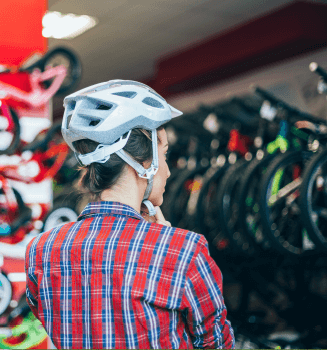
Concussion Prevention: What Works, What Doesn’t
An in-depth review by an international panel of experts says it’s possible to prevent concussions in sports. But the number of effective strategies is slim. Changes to rules and policies show the most promise, while equipment and headgear currently offer little protection in most sports.
The international panel examined more than 13,000 studies. Of these, 48 met standards for inclusion in their analysis. Just over half of the studies targeted youth athletes.
Protective gear
Understanding what is effective is just as important as recognizing what is not, says Kevin Guskiewicz, Ph.D., dean of the College of Arts and Sciences at the University of North Carolina at Chapel Hill and co-director of the Matthew Gfeller Sport-Related Traumatic Brain Injury Research Center.
“We have to know what equipment can prevent concussion, but we also have to know what might create a false sense of security,” he notes. Guskiewicz was not a member of the review panel.
The review panel assessed 24 studies on the protective effects of helmets, other headgear and mouthguards.
Helmets. Helmets can prevent skull fractures, bleeding in the brain and other head and face injuries. But their ability to prevent concussions is “less clear,” according to the authors.
- There is good evidence that children and adults wearing helmets when skiing/snowboarding have significantly fewer head injuries, but not fewer concussions.
- There is “limited” evidence from two studies that helmets reduce concussion risk, but the researchers identified key flaws in both studies that weaken their conclusions.
- There is some evidence that the fit of a helmet can make a difference. In a study that analyzed 3,172 concussions over 9 seasons, high school football players had more symptoms of greater severity that lasted longer if their helmets did not fit properly.
- It’s not clear whether a particular helmet type can reduce the severity or duration of concussions—for example, one with more padding around the cheekbones and jaw.
Some helmets are better than others at dampening forces transmitted to the head, says Guskiewicz. However, “It’s important to recognize there is no concussion-proof helmet. The external padding on the outside of helmets… has likewise not been shown to prevent concussion.”
Face shields. A study by Canadian researchers found that helmets with full-face shields were no more protective against concussion than half shields (visors). But among players who had a concussion, those wearing the shorter shield missed twice as many practices and games, suggesting that full shields may protect against more severe concussions.
Headgear. The effectiveness of padded headgear to prevent concussions remains unproven. In both rugby and soccer, the research is inconsistent; some studies show headgear to be protective and some show it is not. (For more details, see “Are concussions in soccer preventable?”)
Mouthguards. Research on mouthguards has failed to show they protect against concussion. “Mouthguards do a wonderful job of preventing dental trauma,” notes Guskiewicz. “But there has not been a study that has proven that a mouthguard… will actually prevent a concussion.”
Rules and policy changes
In some sports, changes in rules or policies have significantly reduced concussion risk.
In youth ice hockey:
- Banning body checking reduces the risk of concussion by about two-thirds in players 11-12 years old, according to the panel’s analysis.
- A policy of zero-tolerance for head contact has not reduced the number of concussions in youth hockey, although it has been effective in the NHL.
- Fair play rules, which award tournament points to teams with low penalty minutes, can reduce the number and severity of penalties, but their impact on concussions in unclear.
In football:
- A rule change moving the kickoff line five yards closer to the receiving team has had mixed results. A study of the NFL rule showed it significantly reduced the overall number of injuries on kickoff plays, but had no impact on head injuries. In the Ivy League, concussions were dramatically reduced after moving the kickoff from the 35-yard line to the 40-yard line and the touchback line from the 25-yard to 20-yard line. The Ivy League study was published after the international panel’s report and not included in its review.
- It’s not clear whether a policy limiting contact during practices lessens the risk of concussion. In some studies, contact restrictions reduced head impacts, but not concussions, in both high school and youth players. In other studies of youth players, contact restrictions were most protective against concussions (during practice only) when team staff included a certified player safety coach. Larger studies will be necessary before experts feel confident these strategies are effective.
In soccer, a study of professional Norwegian soccer players suggested that stricter enforcement of current rules (handing out more red cards) reduced arm-to-head and leg-to-head injuries by nearly a third. However, the study did not measure the policy’s impact on concussion alone.
The expert panel says educational programs have generally failed to make an impact on concussion risk, though they may improve recognition and management of concussions after they happen.
Future directions
Guskiewicz and others believe advances in concussion prevention may come from changing athlete behaviors that are linked to concussion. For example, some teams are using video to show young athletes improper tackling technique, and teaching a method that reduces impacts to the head. Guskiewicz employs sensors attached to helmets to count impacts to the head and show athletes exercises that may reduce them. University of Washington researchers are testing whether a pregame “huddle” with referees and the opposing team improves sportsmanship and recognition of head injuries.
“It’s never been safer to play sports than it is right now today,” says Guskiewicz. “A lot of that is because of the awareness that’s been created around what a concussion is, the importance of reporting the signs and symptoms, the importance of sitting out and being certain before you go back to play… There’s a lot of benefit to playing sports, and we should keep our kids physically active.”

